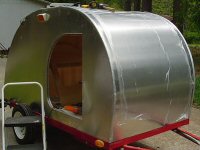What are the advantages of having say a 240w panel vs a 85w panel if charging say 2 batteries.
I assume for instance if you only have a hour of sun and have a 240w panel you got the same energy from 3 hours of a 85w panel being in the sun correct?
Personally i will be living in my mega-tear and will be hooked into power. But solar is a nice backup for if i go off grid for a weekend. Battery wise i have 4 Odyssey PC1200's
solar panel advantage of a bigger panel
7 posts
• Page 1 of 1
The specs for the battery say you can get 44 amp hours out of each battery with a reasonable load. If you draw 25 amps (100 amps for the four) you'll get 78 minutes or somewhat less than the 44 amp hours. So for your four batteries you'll have 176 amp hours available which is pretty good. Unless you go hog wild I don't think you'd need any charging system for a weekend. I'm guessing a reefer would need 3 amps for a 33% duty cycle or 24 or so amp hours a day for a medium Engle type box. With some lighting, a reefer, a fan on low I think you'd still make it through a couple of days without recharging.
If you want sustainable solar power make an estimate of your needs in amp hours. I don't have any experience with solar cells but the ratings are probably best case senerios (the sellers want to look as good as possible!). Maybe others can share their actual experience but I think a reasonable SWAG of what you can expect to get in a full day is maybe the equilivant of 4 hours rated capacity. For the 85 watt panel that would be maybe 28 amp hours and for the 240 watt panel that would be 80 amp hours. Remember you can return home with "empty" batteries so if your weekend useage is less than the 176 amp hours you get from your batteries plus what you can get from your solar cells you'll have enough.
In short, figure out how much you're gonna need to get you through a weekend and act accordingly.
Cheers,
Gus
If you want sustainable solar power make an estimate of your needs in amp hours. I don't have any experience with solar cells but the ratings are probably best case senerios (the sellers want to look as good as possible!). Maybe others can share their actual experience but I think a reasonable SWAG of what you can expect to get in a full day is maybe the equilivant of 4 hours rated capacity. For the 85 watt panel that would be maybe 28 amp hours and for the 240 watt panel that would be 80 amp hours. Remember you can return home with "empty" batteries so if your weekend useage is less than the 176 amp hours you get from your batteries plus what you can get from your solar cells you'll have enough.
In short, figure out how much you're gonna need to get you through a weekend and act accordingly.
Cheers,
Gus
The opinions in this post are my own. My comments are directed to those that might like an alternative approach to those already espoused.There is the right way,the wrong way,the USMC way, your way, my way, and the highway.
"I'm impatient with stupidity. My people have learned to live without it." Klaatu-"The Day the Earth Stood Still"
"You can't handle the truth!"-Jack Nicholson "A Few Good Men"
"Some people spend an entire lifetime wondering if they made a difference in the world. The Marines don't have that problem"-Ronald Reagan
"I'm impatient with stupidity. My people have learned to live without it." Klaatu-"The Day the Earth Stood Still"
"You can't handle the truth!"-Jack Nicholson "A Few Good Men"
"Some people spend an entire lifetime wondering if they made a difference in the world. The Marines don't have that problem"-Ronald Reagan
-

eamarquardt - Silver Donating Member
- Posts: 3179
- Images: 150
- Joined: Sat Nov 11, 2006 11:00 pm
- Location: Simi Valley, State of Euphoria (Ca)

 .
.
